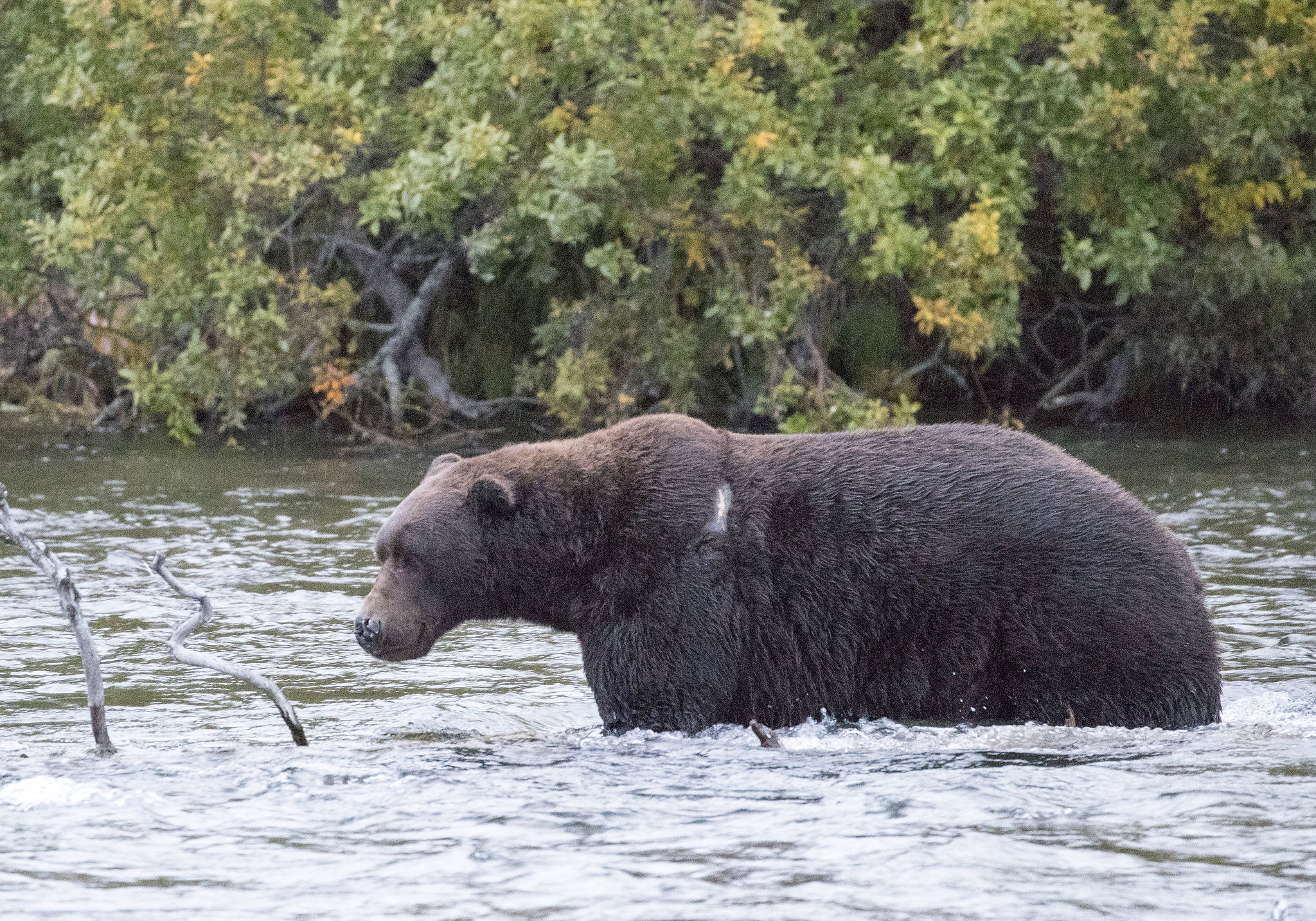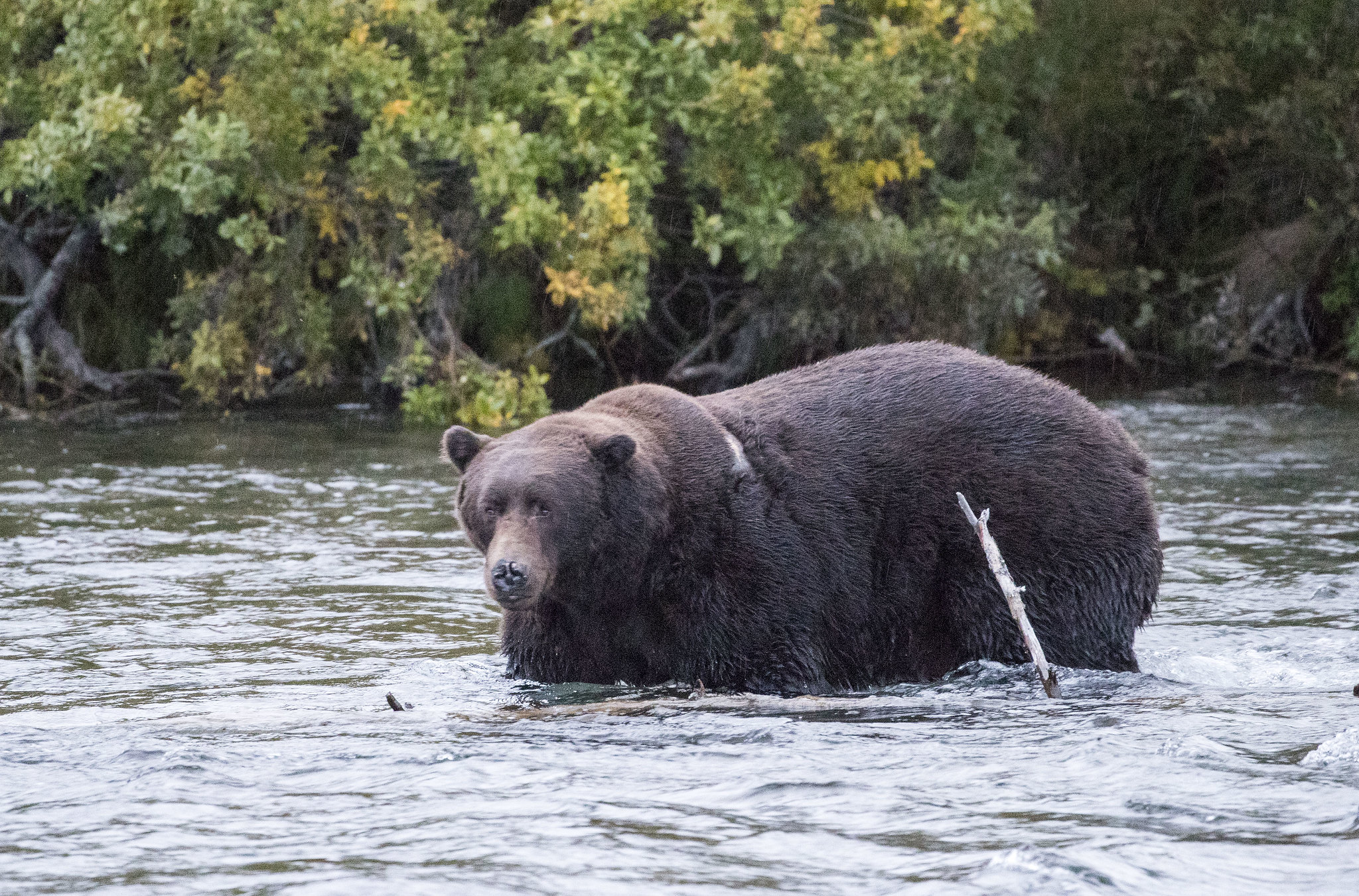It’s not uncommon to see bears with open wounds and distinctive scars, like bear 83 who seems to repeatedly get injured.

Photo of 83’s wound from 2015. In 2016, his rump was injured again courtesy of bear 747.
Wounds and the subsequent scars are useful when identifying Brooks River’s bears, since each bear carries a unique suite of them. 83 now sports a large scar on his rump.

The lump on 83’s rump marks the scar from his 2015 injury.
Sometimes though, we see bears with scars or injuries that may be more than superficial, perhaps impacting the sense they rely on most.
On September 13, 2017, a bear with a large, distinctive scar on his left shoulder was photographed at Brooks River.
Most distinctively, his nose is split.
This appears to be an old injury and when I saw these photos I wondered have we seen this bear before?
In 2010 and 2011, a subadult bear with a torn nostril was seen at Brooks River. Bear 253 was a young subadult at the time, but Katmai’s bear monitor was not able to determine its sex. Its nose was most likely injured in 2010 as photos from 2011 show some healing.
253 probably isn’t the unidentified male photographed with the nose injury this past September though. 253’s muzzle is long and somewhat pointed while the male bear’s muzzle is blockier in shape. The nose injury on the male bear also seems more symmetrical than 253’s.
Would injuries like these impair these bears’ sense of smell? Perhaps, especially if it reduced the surface area inside the nose where scent can be detected.
Bears have a legendary sense of smell. The inside of their nose is filled with many turbinals, a complex scaffold of paper-thin bones. Humans have turbinal bones too, just far less than ursids. In black bears, for example, these bones greatly increase the surface area inside the nasal cavity, providing 100 times more nasal mucosa, or mucous membranes, than humans. More tangibly, if the area of muscous membranes inside the human nose equals the area of your typical postage stamp, then the area covered by mucous membranes inside the black bear nose covers an 8.5 x 11” sheet of office paper. On the surface of the membranes are millions and millions of scent detecting cells. In short, bears live in a world of odors we can scarcely imagine.
Like human eyesight, hearing, and smell, the strength of these senses likely varies in bears. Some bears may have worse eyesight than others (although it’s a myth that bears have poor eyesight; they don’t). Others may have worse hearing. In the case of bears with injured noses, they may not be able to smell as well as their cohorts. (It’s important to note that in the case of 253 and the adult male seen this past September, the injury to their nose may not be deep enough to affect the turbinals.)
If bears are anything though, they are tough survivalists. A nose injury could impose a severe disability on them, but that won’t stop them from doing whatever they need to do to survive.








Brilliant. Thank you!
LikeLike
Pingback: Bear Cam Week in Review September 29 | Explore
Thanks for your insight Mike. Always good to hear your thoughts and gain from your knowledge. Thanks so much for sharing.
LikeLike
Hi Mike. I have been away and missed the injured-nosed bear. I am glad to hear that he appears to be doing well in spite of his injury. He certainly looks big and fat. I am actually surprised, given the length of their claws, that more bears don’t suffer injuries to their noses and eyes. (Although, perhaps the really serious injuries prove fatal and thus are never seen.)
Off topic question for you… We spent today at Sequoia NP. It was a two bear day and the second bear (treed near the Sherman Tree with an audience of 50+) had a tag in its right ear – A16. Is there any way to find out who is doing bear research there and what the numbers mean? Google is proving singularly unhelpful… Thanks!!!
LikeLike
The tag could be part of a larger research project, but it could also be to assist with management of the bears. At Sequoia, bears who have been conditioned to human food may be tranquilized and given an ear tag to assist in its ID.
LikeLike
Thanks Mike. A16 was the most people dense place in the park…and was willing to come down a tree with many, many people around. There were bear lockers and signs all over the place, but many of the people we traveled the trails with didn’t speak English. And many were quite cavalier, with both food and themselves. The mother, for example, who was willing to lead her 5 year old daughter up to a tree where a bear was descending. Sigh.
LikeLike
Greatt reading
LikeLike